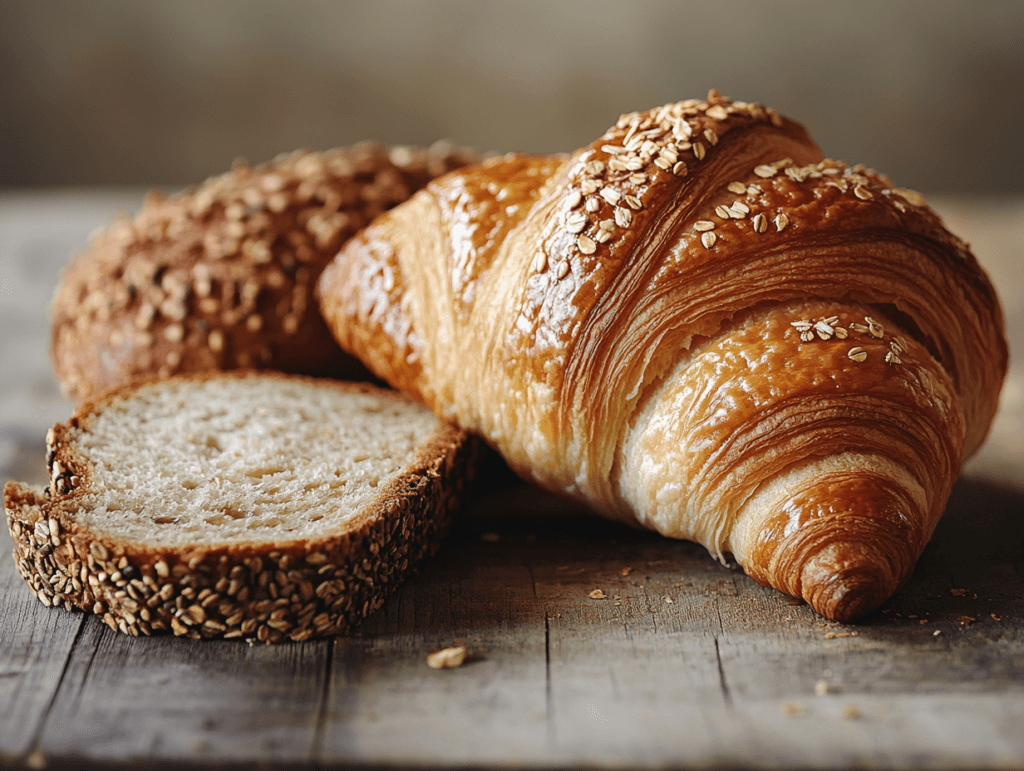Are croissants healthier than bread? This is a common question for those looking to make informed dietary choices. While both are popular breakfast options, they differ significantly in calories, fat content, fiber, and overall nutritional value.
Croissants are known for their rich, buttery flavor and flaky texture, but they are also high in calories and saturated fats. On the other hand, bread—especially whole-grain bread—is lower in fat, higher in fiber, and packed with essential nutrients.
If your goal is weight management, heart health, or balanced nutrition, whole-grain bread is the healthier option. However, croissants can still be enjoyed in moderation as an occasional treat.
By understanding the key differences in their nutritional profiles and health implications, you can make the best choice based on your dietary needs.
Table of Contents
Nutritional Profiles of Croissants and Bread
When comparing croissants and bread, the nutritional profiles offer the first significant insight into their health implications. Both foods contain macronutrients like carbohydrates, proteins, and fats, but the composition and quantity differ significantly.
Macronutrient Content
- Calories
Croissants are significantly more calorie-dense than bread due to their high butter content. A plain croissant contains approximately 230–280 calories, while a slice of white bread has 70–80 calories, and whole-grain bread averages 90–100 calories per slice. Choosing whole-grain bread over croissants can help with calorie control and weight management. - Carbohydrates
Both croissants and bread provide carbohydrates, but bread—especially whole-grain varieties—offers more complex carbohydrates and fiber. A croissant contains 25–30 grams of carbohydrates, whereas a slice of bread has 12–20 grams. The higher fiber content in whole-grain bread supports digestion, promotes satiety, and helps regulate blood sugar levels. - Protein
Bread generally has slightly more protein than croissants, with whole-grain bread containing around 4–5 grams per slice, compared to 3–4 grams in a croissant. Protein is essential for muscle repair and overall bodily function, making this a critical distinction for health-conscious eaters. - Fats
Fat content is one of the most significant differences between croissants and bread. A croissant contains 12–15 grams of fat, primarily from butter, whereas most bread varieties contain little to no fat. This makes bread a lower-fat alternative, particularly for those following a heart-healthy diet.
Vitamins and Minerals
Croissants and bread also differ in their micronutrient offerings.
- Croissants
- Croissants are relatively low in vitamins and minerals, though they may contain small amounts of iron and calcium.
- Enriched croissants may provide additional nutrients, but these are often added synthetically.
- Bread
- Bread, especially whole-grain varieties, offers a wider range of essential nutrients, including B vitamins, iron, magnesium, and zinc.
- Whole-grain bread also provides antioxidants and phytonutrients, contributing to overall health.
Fiber Content
Fiber is an important nutrient for digestion and overall health.
- Bread: Whole-grain bread is a significant source of dietary fiber, with about 2–3 grams per slice, supporting gut health and stabilizing blood sugar levels.
- Croissants: With less than 1 gram of fiber per serving, croissants fall short in this area, offering minimal benefits for digestion or blood sugar control.
This nutritional analysis shows that bread, especially whole-grain varieties, is often the healthier choice compared to croissants due to its balanced profile. However, whether croissants or bread is healthier ultimately depends on individual dietary needs and portion control.
Health Implications of Eating Croissants vs. Bread
Understanding whether croissants or bread is the healthier option involves analyzing their effects on weight management, blood sugar levels, cholesterol, and cardiovascular health.
Weight Management
- Calorie Considerations
Croissants are calorie-dense due to their high butter content. This makes them less ideal for those aiming to lose or maintain weight, particularly if consumed in large portions or paired with calorie-rich fillings like jam or cream.
Bread, particularly whole-grain options, is lower in calories and contains more fiber, making it a better choice for those seeking to manage their weight. Fiber promotes satiety, helping individuals feel fuller for longer. - Portion Control
A single croissant typically constitutes one serving, but its high calorie and fat content means the impact on daily intake can be significant. Bread offers more flexibility; consuming one or two slices allows for easier portion control and caloric moderation.
Blood Sugar Levels and Glycemic Index
- Croissants
Made with refined flour, croissants have a high glycemic index (GI), meaning they cause rapid spikes in blood sugar levels. This can be problematic for people with diabetes or insulin resistance. - Bread
The impact of bread on blood sugar depends on the type. White bread has a high GI, similar to croissants, but whole-grain bread has a lower GI, thanks to its fiber content, which slows digestion and stabilizes blood sugar levels.
Cardiovascular Health
- Croissants
The high butter content in croissants leads to higher saturated fat intake, which can increase LDL (bad) cholesterol levels and raise the risk of heart disease if consumed frequently. - Bread
Whole-grain bread is heart-healthier because it contains fiber, antioxidants, and essential nutrients. Studies show that regular consumption of whole grains reduces the risk of heart disease, type 2 diabetes, and certain cancers.
Are croissants healthier than bread?
Studies reveal that incorporating whole grains, like whole-grain bread, into your diet lowers the risks of heart disease, type 2 diabetes, and certain cancers. In contrast, eating calorie- and fat-dense foods, such as croissants, frequently increases the likelihood of weight gain and elevated cholesterol levels. As a result, bread often serves as a healthier choice for maintaining cardiovascular health.
While an occasional croissant as part of a balanced diet is unlikely to cause harm, regular consumption of bread—especially whole-grain varieties—is a more heart-friendly option.
Preparation and Ingredients of Croissants and Bread

The preparation methods of croissants and bread play a major role in shaping their nutritional profiles and health impacts. These differences help explain why croissants are higher in fats and calories, while bread—depending on its type and ingredients—can range from simple to significantly healthier options.
How Croissants Are Made
Croissants are a type of laminated pastry, requiring repeated folding and layering of butter into dough to create their signature flaky texture. This process significantly increases their fat and calorie content compared to bread.
- Ingredients
- Butter – Essential for the flaky, rich texture, but also the main contributor to high saturated fat content.
- Refined White Flour – Low in fiber, making croissants a less nutritious choice.
- Sugar – Adds sweetness but slightly raises the glycemic index (GI).
- Preparation Process
The process of making croissant dough, known as lamination, involves repeatedly folding and rolling butter into the dough to form multiple layers. This intricate technique enhances the croissant’s texture but also substantially raises its fat and calorie content.
How Bread Is Made
Bread is made from flour, water, yeast, and salt, with variations depending on the type. Whole-grain bread retains fiber, vitamins, and minerals, making it a healthier choice.
- Ingredients
- Flour: Bread can be made with white, whole-grain, or specialty flours (e.g., rye or spelt). Whole-grain flours retain the bran and germ, providing more fiber and nutrients.
- Water: A fundamental ingredient that combines with flour to form the dough.
- Yeast or Sourdough Starter: Used to leaven the dough, yeast and sourdough starters give bread its rise and texture.
- Salt: Adds flavor and regulates fermentation.
- Optional Additions: Seeds, nuts, and grains may be added to enhance nutritional value.
- Preparation Process
The dough is mixed, kneaded, allowed to rise, shaped, and baked. The simplicity of this process means bread often contains fewer calories and fats than croissants. Whole-grain breads are particularly beneficial due to their minimal processing and nutrient density.
Additives and Preservatives
- Croissants
Store-bought croissants may contain preservatives, artificial flavors, and hydrogenated oils to extend shelf life. These additives can negatively impact health, particularly when consumed frequently. - Bread
Commercially produced bread may also contain additives and preservatives. However, artisanal and whole-grain varieties are often made with minimal or no additives, making them a healthier choice.
The Impact of Ingredients on Health
- Croissants
The high butter content and refined flour make croissants a more indulgent option. While delicious, they should be treated as an occasional treat rather than a staple food. - Bread
The nutritional value of bread depends on the type chosen. Whole-grain bread is rich in fiber, vitamins, and minerals, making it a healthier choice for daily consumption. White bread, while less nutritious, still offers flexibility for pairing with nutrient-rich toppings.
By understanding these preparation methods and ingredient differences, it’s clear why croissants are richer and more calorie-dense, while bread—particularly whole-grain varieties—is a more versatile and health-conscious choice.
Portion Sizes and Consumption Habits of Croissants and Bread
Portion Control
- Croissants: A single croissant weighs 60–80 grams and contains 230–280 calories. Eating croissants frequently or in large portions can quickly exceed daily calorie needs, leading to weight gain.
- Bread: A standard slice of bread weighs 30–40 grams and contains significantly fewer calories. This makes it easier to control portions, especially when paired with healthy toppings like avocado, hummus, or lean protein.
Common Serving Styles
- Croissants: Often served as a breakfast pastry, paired with coffee or tea. Variations include chocolate-filled, almond, or ham and cheese croissants, which further increase calories, sugar, and fat intake.
- Bread: More versatile, served as toast, sandwiches, or alongside meals. It can be paired with nutritious toppings like eggs, peanut butter, or salmon to enhance its health benefits.
Cultural and Habitual Differences
Cultural preferences and habits often dictate how croissants and bread are incorporated into diets.
- Croissants: Croissants, which originated in France, symbolize indulgence and are often enjoyed during leisurely breakfasts or special occasions in many cultures. However, in regions where croissants are a common breakfast staple, frequent consumption can pose health challenges due to their high fat and calorie content.
- Bread: Bread has a long history as a dietary staple worldwide. From sourdough in Europe to flatbreads in the Middle East and whole-grain loaves in North America, bread is a ubiquitous food that adapts to local cuisines. Its widespread availability and variety make it a more practical and healthier daily option in many diets.
Managing Habits for Better Health
To maximize health benefits while minimizing risks, adopting mindful consumption habits is key.
Croissants
- Limit croissants to occasional treats rather than daily staples.
- Opt for smaller croissants or share one with a friend to control portion sizes.
- Pair with healthier options like fresh fruit or a small serving of yogurt to balance the meal.
Bread
- Choose whole-grain or sourdough bread over white bread for better nutrition.
- Use bread as a vehicle for nutrient-dense toppings, such as avocado, smoked salmon, or nut butter.
- Watch out for added sugars or preservatives in commercially produced bread and select artisanal or minimally processed varieties when possible.
By being mindful of portion sizes and pairing these foods with healthier options, both croissants and bread can fit into a balanced diet. However, bread offers greater flexibility and fewer risks of overindulgence due to its lower calorie density and more diverse nutritional profile.
Frequently Asked Questions
Are croissants a good breakfast choice?
Croissants can be a satisfying breakfast option due to their rich, buttery taste and flaky texture. However, their high calorie and fat content make them less ideal for daily consumption. Pairing a croissant with fresh fruit or yogurt can improve the nutritional balance of your breakfast. For a healthier everyday choice, consider whole-grain bread, which provides more fiber and sustained energy. Learn more about balanced breakfast options in What Are the Three Types of Brownies? for a creative twist on morning indulgence.
Which is better for a low-carb diet: croissants or bread?
If you’re following a low-carb diet, neither croissants nor bread are optimal choices, as both are high in carbohydrates. That said, croissants typically have slightly fewer carbs per serving compared to a few slices of bread. However, the higher fat content in croissants makes them calorie-dense, which might not align with certain low-carb weight management goals. Low-carb bread alternatives, such as those made from almond or coconut flour, might be a better fit. Discover creative recipes like Purple Sweet Potato Recipe for low-carb inspiration.
Is whole-grain bread better than croissants nutritionally?
Yes, whole-grain bread is generally better than croissants in terms of nutrition. Whole-grain bread is rich in fiber, vitamins, and minerals, and has a lower fat content. It also promotes heart health and aids in digestion. Croissants, on the other hand, are lower in fiber and higher in saturated fats, making them a less balanced choice nutritionally.
Do croissants have more sugar than bread?
Plain croissants usually contain more sugar than plain bread, though the difference is not dramatic. Sweetened or flavored croissants, such as chocolate or almond varieties, have significantly more sugar. Whole-grain bread, particularly unsweetened varieties, has the least sugar and is a better option for those looking to minimize sugar intake.
Can croissants be part of a healthy diet?
Yes, croissants can be part of a healthy diet when enjoyed in moderation. They are best reserved for occasional indulgence rather than daily consumption. To balance their high fat and calorie content, pair croissants with nutrient-dense foods like fruit or vegetables.
What makes bread healthier than croissants in some cases?
Bread, particularly whole-grain varieties, is healthier than croissants due to its lower fat content, higher fiber levels, and richer nutrient profile. Bread is also more versatile, allowing for healthier combinations with other foods like lean proteins, healthy fats, and vegetables.
Conclusion
When comparing croissants and bread, the “healthier” option largely depends on your dietary needs, preferences, and frequency of consumption. Croissants, with their buttery layers and indulgent flavor, are best enjoyed occasionally as a treat. They are calorie-dense and rich in saturated fats, making them less ideal for everyday consumption, especially for those managing weight or heart health. Learn more about indulgent choices in the Gipfeli Recipe: The Ultimate Guide to a Swiss Delicacy.
Bread, particularly whole-grain varieties, stands out as a more balanced and versatile option. It offers essential nutrients like fiber, B vitamins, and minerals while being lower in calories and fat compared to croissants. Bread can easily be integrated into a healthy diet, serving as a vehicle for nutrient-dense toppings and balanced meals.
Ultimately, both croissants and bread have their place in a well-rounded diet. The key lies in mindful consumption, portion control, and pairing these foods with healthier choices to support your overall health goals.

